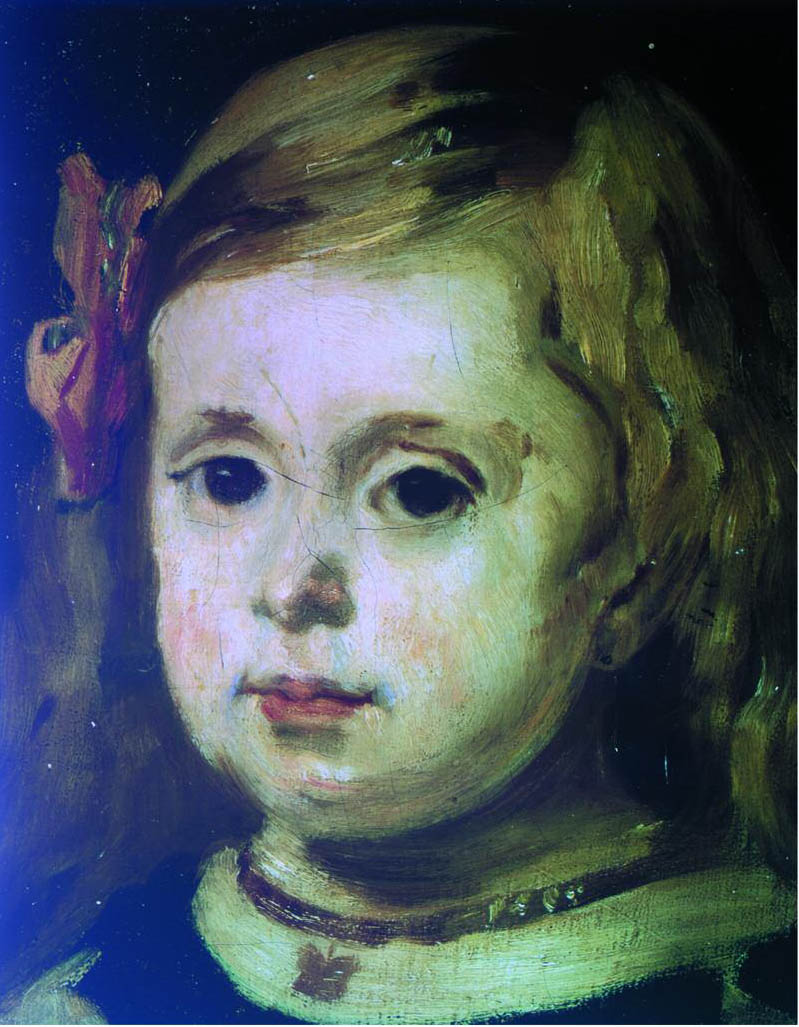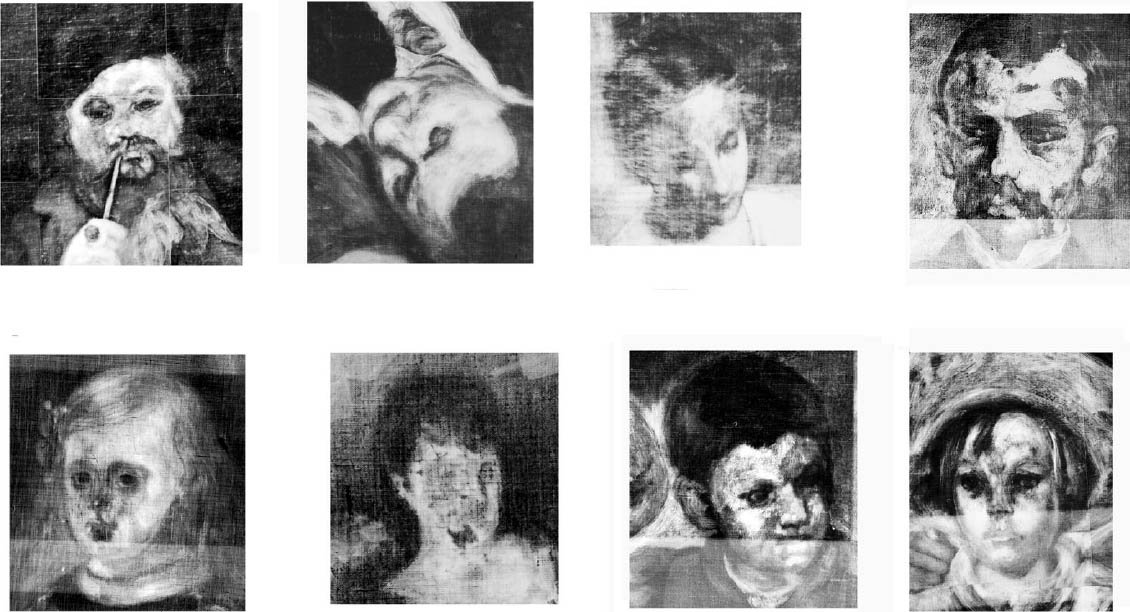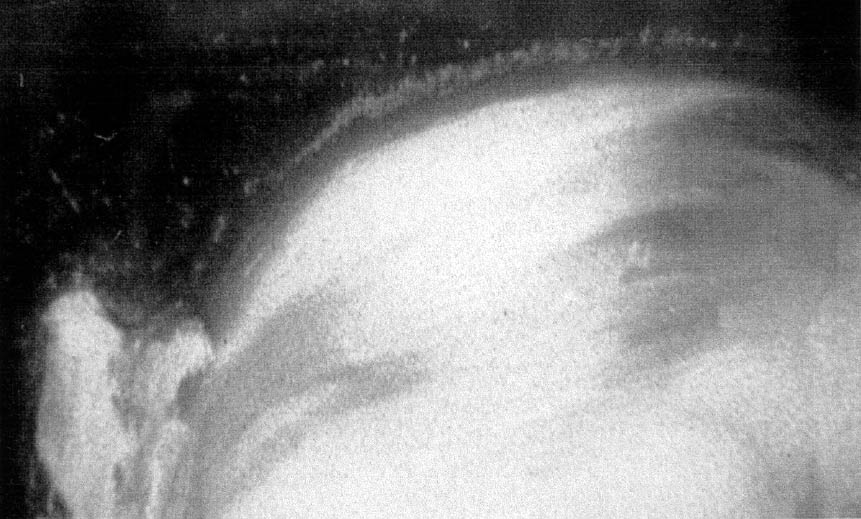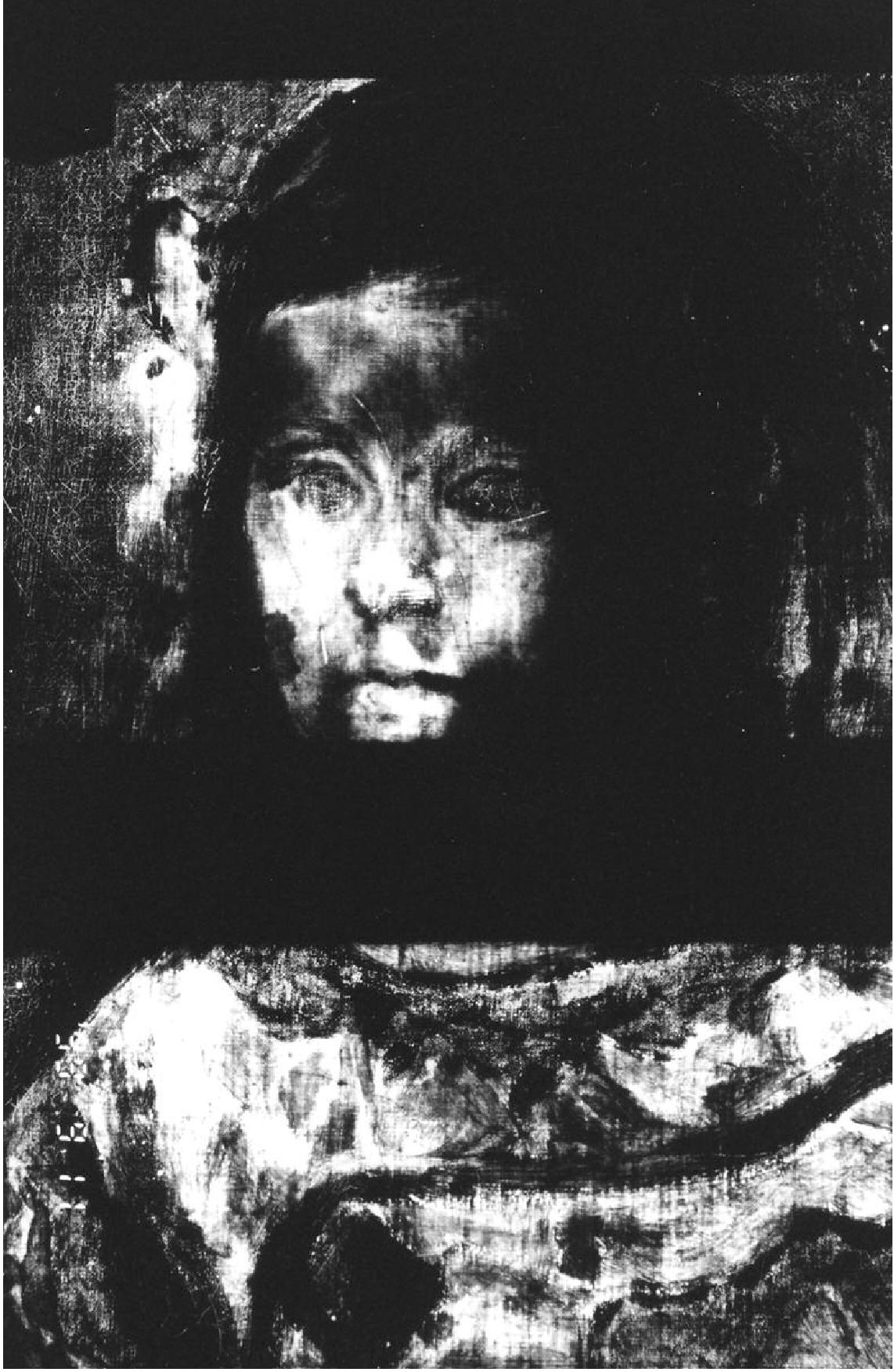MANET'S LOST INFANTAALBERT BOIME, & ALEXANDER KOSSOLAPOV
3 NONDESTRUCTIVE TECHNICAL EXAMINATIONIt is worth emphasizing from the very beginning that as soon as the painting was dated and located in Paris by McCrone's report, the field of contenders for authorship of the work was drastically reduced. Although sketch/copies were standard studio practice at the time, the example under consideration still displays singular traits of execution. There were only a handful of artists who, by 1860–62, had developed that “advanced” manner in which the Infanta was executed, and even mere surface observation reveals the color scheme of the Infanta to be an exact match with Manet's contemporaneous palette. We will not proceed, however, along this line of reasoning, but confine ourselves to a purely technical comparison of Manet's production techniques and style (as established both by our own scientific examination of his paintings created around 1860 and by the existing literature, including in particular Michael Wilson's landmark study of the technical methods and procedures of the artist who painted this Infanta [Wilson 1983]). 1. The artist's original outline sketch was done on the white ground of the canvas, painted in some darker color with scarcely any lead white, and appearing as dark fragments (e.g., the hair, eyes, mouth, etc. also look pitchy on the x-ray radiographs). The unfinished portrait of George Moore au Caf� (ca. 1878, Metropolitan Museum of Art, New York) presents such sketched outlines made in this kind of paint: “the lines of the head are brown, the coat and hat are blue-black” (Wilson 1983, 8). Manet's sketching process, however, is revealed neither on his finished paintings by x-rays, as the sketch outlines do not contain enough lead white, nor by infrared photography, as the material used for sketching is deficient in carbon black. On the Infanta, however, the presence of preparatory sketching may be traced on an enlarged photograph of the face (fig. 6, seepage 442) in those areas not built up with pigment during the subsequent modeling. Such areas may be seen, for example, in her upper lip below the left nostril and in the corners of her mouth. These minuscule areas, of course, do not provide us enough information on the sketching method itself but are indicative of its practice.
2. On the finished sketch an underpainting (i.e., the lay-in of three-dimensional objects) begins in darker colors containing less lead white and ends with an almost pure white on the brightest parts. The modeling brushstrokes can be straight or curvy, short or elongated, as they follow the anatomically convex and concave parts of the face. This same manner of underpainting is clearly seen in the Infanta (see fig. 6, page 442), where the darker underpainting shows up in several areas. A comparison of the brushstrokes of the Infanta with those of two other Manet paintings (the boy's face in The Old Musician [ca. 1862, National Gallery of Art] and the forehead of The Dead Toreador [ca. 1862, National Gallery of Art]), discloses brushstrokes of the same type definitely present in all (fig. 7) that verify Manet's “handwriting” on the Infanta. 3. Manet typically applied his paint in a viscous, semidry impasto. The traces of the brush in the hair are usually seen in longer lead-white strokes, while the short ones generously used on smaller light spots/areas are less clearly resolved. These shorter strokes, densely set down, explain why many light regions on radiographs have jagged, torn edges. The light, elevated regions are modeled extremely roughly, almost sculpted rather than painted. Visually such areas, typical for Manet, may be easily traced on figure 6 in the Infanta's left cheek, under her lower lip, on the left part of her chin, under her right eye, and so on. 4. The very idea of following the natural light distribution was alien to the artist. Manet, in principle, did not care about the smooth transition of light to shadow; the thick, bright-white brushstrokes are abruptly juxtaposed with the darker parts as if he ignores the very existence of intermediate halftones, which do not figure in his palette at all (Boime 1971; Wilson 1983). As a result of this technique, the boundary between dark (hair, background) and light
In our investigation we carefully studied the majority of existing x-ray radiographs of the early Manet paintings. In this article, however, we chose for technical comparison several representative examples taken from the paintings dating ca. 1862 (fig. 8): The Old Musician (National Gallery, Washington), The Dead Toreador (National Gallery), La Femme � la Cr�che (Ordrupgaard Collection, Copenhagen), The Spanish Ballet (Phillips Collection), Le Bon Bock, (Philadelphia Museum of Art), Portrait of a Man (Rijksmuseum, Kr�ller-M�ller, Otterlo, Holland). The radiograph of a single Manet copy was available to us, the Self-Portrait of Tintoretto (1854, Mus�e des Beaux Arts, Dijon), a painting crucial for our purpose, but unfortunately we have not received permission to reproduce it. We have included the radiograph of the Infanta's face in the series to show a comparison that to us is self-evident: the Infanta is wearing the same sort of “mask” that everybody else wears in the Manet paintings illustrated. What is especially interesting in this example is that the Infanta's mask is formed by the borderline between her forehead and her hair, despite her hair's not being black but of a lighter color. This feature indicates that the forehead was joined to the black/darker hair during the underpainting stage, while in the finishing stage the hairdo was impastoed in light. In other words, it indicates that the artist followed a manner quite identical to that shown in the other Manet paintings pictured. Significantly, we may also look at the much later (1879) painting of Mlle. Isabelle Lemonnier to demonstrate that Manet did not abandon his “masking” habit for many years following the period under discussion. 5. Probably the most important, patently observable characteristic of Manet's alla prima painting in thick impasto (this technique implies that the volume and coloring were sought simultaneously by the artist) was his strange need to scrape away what he saw as unnecessary paint in order to reveal the more appropriate darker color beneath it. Michael Wilson, who follows, in his turn, the critics Th�odore Duret and George Moore, has ably noted this peculiar feature:“As he applied washes of color to his painted drawing, Manet would continuously revise the contours of his image. Where the paint was thickly laid on he would often scrape it away to allow the ground to show through. … When he was dissatisfied he would scrape away and repaint over and over
In line with this process, we would be inclined to add one related observation, that the overwhelming majority of Manet's works, excepting his copies, reveal on x-ray radiographs total or local compositional changes. Even on his copies, however, as we have seen, Manet at least revised the contours. To proceed along this important line of inquiry, we must briefly comment on certain technical aspects of this scraping process. The result of the scraping of white lead—rich paint on the contours may not be seen well on x-ray radiographs if the scraping did not produce noticeable defects in the lead-rich ground of the painting. What we may be able to see on the radiographs are just a few more jagged edges on the borders between dark and light regions, the effect of which can be well disguised by the technical feature described above (3). The transmitted light photographs (TLPH) and/or reflected infrared photographs, however, can indeed reveal the scraping rather well in cases where the underpainting done with a darker paint on a white background has been scraped away. As few specialists are familiar in practice with these techniques, it may be helpful to explain very briefly the difference between x-ray radiographs and TLPH. For x-ray, the main absorbing pigment in paintings is lead white. As a result, what we see on a radiograph is the lead-white presence, or its distribution, in the painting. For TLPH, the main absorbing paints are those that contain carbon black (burnt bone, charcoal, or soot). When TLPH is made in the infrared region (at wavelength greater than 1.6–1.8 �m), it reveals predominantly the presence of carbon black; when it is made in visual light, it reveals the distribution of all darker, light-absorbing pigments. Lead white, for example, does not absorb light well; its “hiding power” is based on the effective scattering Reflected infrared photographs work, in principle, similarly to common reflected light photography, except that in the infrared spectrum the coefficients of reflection/absorption for artistic pigments differ very much from the corresponding coefficients in the visual range. In particular, in the near infrared, absorption of a majority of pigments is negligible, unlike the visual region (to which main absorption bands of such pigments belong, providing their corresponding colors), and the reflected infrared photography practically does not disclose absorption at all for all pigments with just one exception— carbon black—the pigment for which absorption stays high, almost the same as it is in the visual range. As for the artists' pigments' reflection/scattering, it falls approximately linearly with the increase of the wavelength, and as their absorption stays low, paint layers become more transparent (less reflective) the longer the infrared wavelength chosen for photography. The carbon black–based pigments, though, practically do not change their very high light absorption in the near infrared, and consequently their level of reflectivity remains low. Due to such effects, reflected infrared photographs can help to trace the distribution of carbon black (or pigments containing carbon black) on a painting, revealing, by the way, even the carbon black underpainting or underdrawing hidden under the upper paint layers. Thus, on the reflected infrared photographs, free carbon—containing pigments (visually looking dark/black) are rendered black as they would be in the common visual range photographs, but with much higher contrast due to very small absorption of all other types of pigments looking white (nonabsorbing). If we bear in mind that Manet consistently used white/light grounds on his paintings and that his individual manner included the scraping of his own paint even down into the ground (i.e., at times he scraped away the darker, carbon black underpainting as well), there are excellent opportunities to view the scraping both in TLPH and in reflected infrared. In TLPH the scrapings may look like white lines with jagged contours on the darker background, as the light passing through such scraping is less absorbed compared with the neighboring, nonscraped background. In the infrared the scrapings also look white because the well-reflecting ground is “seen” through the scrapings. In both cases, scraped lines may be situated along the borders of light and shadow zones, where the contours allegedly have been “revised.” As we have thus established certain specific technological criteria for the revealing of scraping, we may now apply them to the Infanta. In figure 9, taken in reflected infrared, the scraping (the broad, lighter-looking scratch with jagged edges) can be definitely traced. The paint was scraped down to the ground of
At the same time, it is necessary to discuss certain differences that the Infanta presents on the radiographs in the comparative series shown in figure 8. The difference is that the painting on the Infanta's face is somehow less full-bodied, the lead-white layer thinner and less “sculptured” than in the other examples. For this reason one cannot clearly see the modeling brushstrokes here, and, as a result, the face looks less spotty, painted less “aggressively” than the other faces on the x-ray radiographs. Significant compositional changes are absent as well. To be scrupulous, we must note that the modeling is performed with a thinner brush than was used, for example, on The Old Musician. We believe that such differences may be explained when we recollect that the painting under examination is indeed a copy, and that the copying process may, by definition,
|





